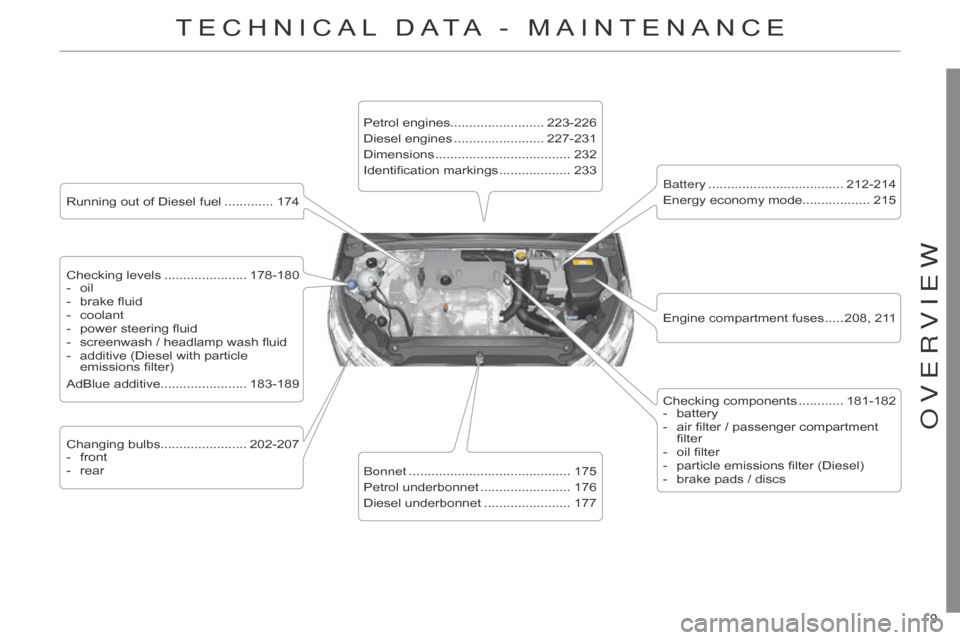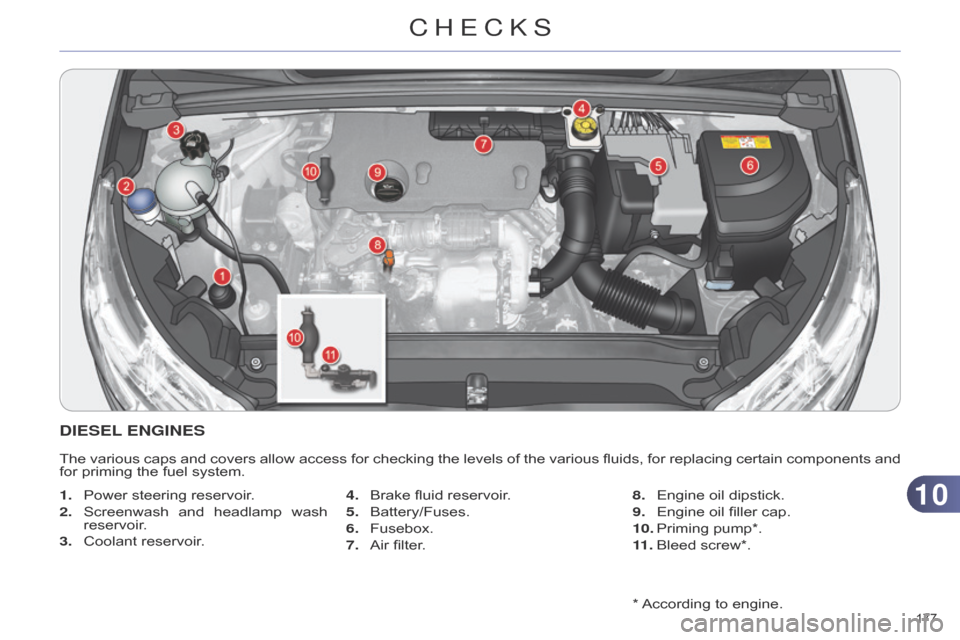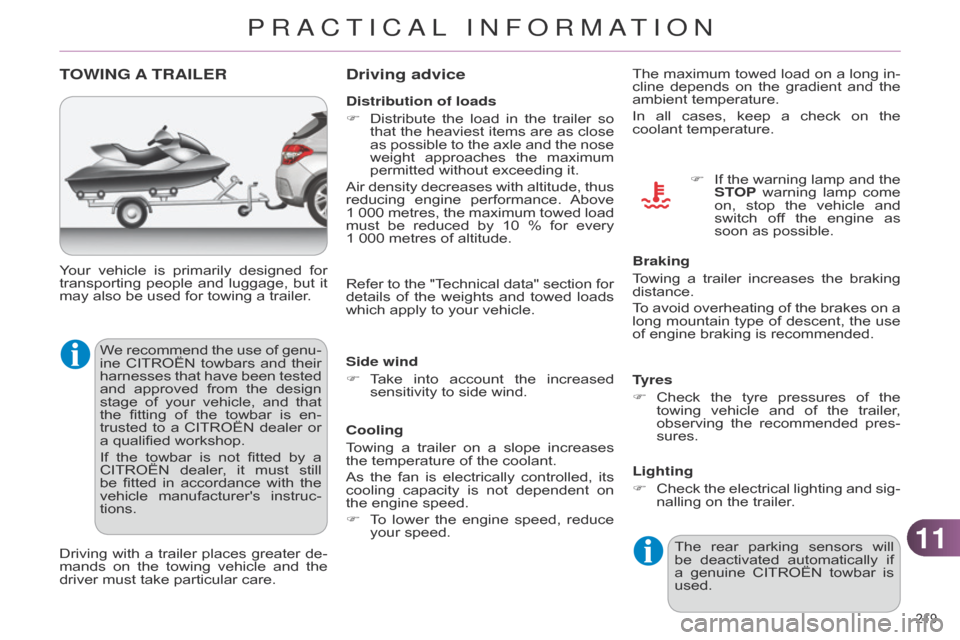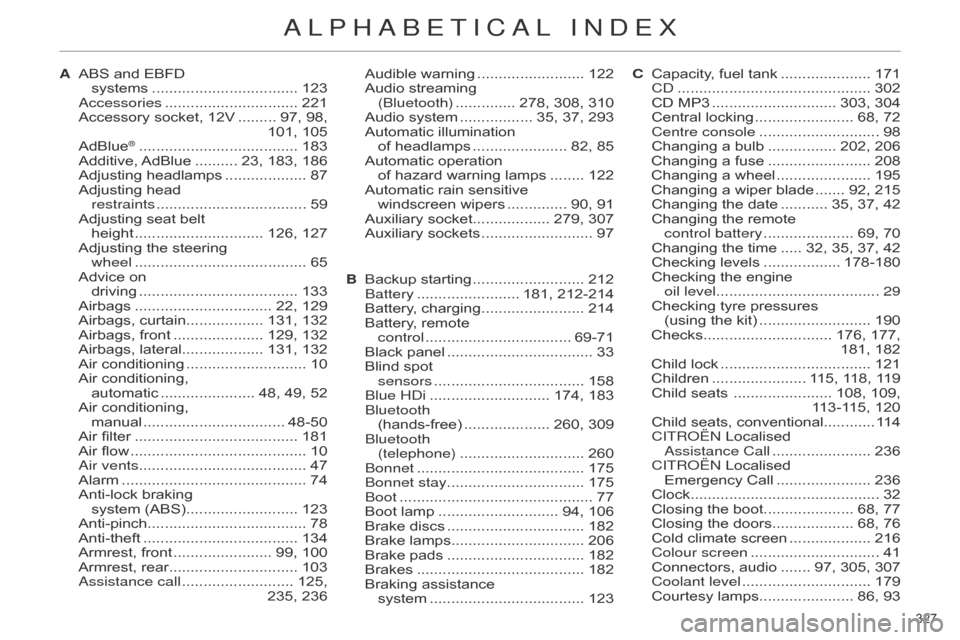engine coolant Citroen C4 DAG 2014.5 2.G Owner's Manual
[x] Cancel search | Manufacturer: CITROEN, Model Year: 2014.5, Model line: C4 DAG, Model: Citroen C4 DAG 2014.5 2.GPages: 340, PDF Size: 12.89 MB
Page 11 of 340

9
C4-2_en_Chap00b_vue-ensemble_ed01-2014
9
C4-2_en_Chap00b_vue-ensemble_ed01-2014
TECHNICAL DATA - MAINTENANCE
Running out of Diesel fuel ............. 174
Checking levels
...................... 178-180
-
oil
-
brake
fluid
-
coolant
-
power
steering fluid
-
screenwash
/ headlamp wash fluid
-
additive
(Diesel with particle
emissions
filter)
AdBlue
additive....................... 183-189
Changing
bulbs....................... 202-207
-
front
-
rear Petrol
engines......................... 223-226
Diesel engines
........................ 227-231
Dimensions
.................................... 232
Identification
markings
................... 233
b
onnet
........................................... 175
Petrol
underbonnet
........................ 176
Diesel
underbonnet
....................... 177Checking
components
............ 181-182
-
battery
-
air
filter / passenger compartment
filter
-
oil
filter
-
particle
emissions filter (Diesel)
-
brake
pads / discs
b
attery
.................................... 212-214
Energy
economy mode.................. 215
Engine compartment fuses
..... 208,
211
oVERVIEW
Page 18 of 340

16
C4-2_en_Chap01_controle-de-marche_ed01-2014
Warning and indicator lamps
Visual indicators which inform the driver of the occurrence of a malfunction (warn -
ing lamp) or of the operation of a system (operation or deactivation indicator lamp).
When the ignition is switched on
Certain
warning
lamps
come
on
for
a
few
seconds
when
the
ignition
is
switched
on.
When
the engine is started, these warning lamps should go off.
If
they
remain
on,
before
moving
of
f,
refer
to
the
information
on
the
warning
lamp
in
question.
Associated warnings
The
illu
mination,
fixed
or
flashing,
of
certain
warning
lamps
may
be
accompanied
by
an audible signal and the display of a message.
Warning lamps
When the engine is running or the vehicle is being driven, the illumination of one of the fol -
lowing warning lamps indicates a malfunction which requires action on the part of the driver .
The
warning comes on in the instrument panel.
If your vehicle has a screen, a
warning lamp coming on is al -
ways
accompanied
by
the
dis
-
play
of
an
additional
message,
to
assist
you
in
identifying
the
problem.
If
you
encounter
any
problems,
do
not
hesitate
to
contact
a
CITROËN
dealer
or
a
qualified
workshop.
W
arning/indicator lamp is onCause Action/Observations
STOP fixed,
alone
or
associated
with another
warning
lamp,
accompanied
by
an
audible
signal
and
a
message
in
the
screen. Illumination
of
this
warning
lamp
is
associated
with
a
serious
fault
with
the
braking
system,
power
steering,
engine
lubrication
system
or
cooling
system. Stop
as
soon as it is safe to do so as
there
is
a
risk that the engine will cut out
while
driving.
Park,
switch off the ignition and contact a
CITROËN
dealer
or
a
qualified
workshop.
Maximum
coolant
temperature fixed
red. The
temperature
of
the
cooling
system
is
too
high. Stop
as
soon as it is safe to do so.
Wait
until
the engine has cooled down
before
topping up the level, if necessary.
If
the
problem persists, contact a
CITROËN
dealer or qualified workshop.
1
MONITORING
Page 178 of 340

1010
176
C4-2_en_Chap10_verification_ed01-2014
PETROL ENGINES
The various caps and covers allow access for checking the levels of the various fluids and for replacing certain components.
1.
Power
steering reservoir.
2.
Screenwash
and
headlamp
wash
reservoir
.
3.
Coolant
reservoir. 4.
Brake
fluid reservoir.
5.
Battery/Fuses.
6.
Fusebox.7.
Air
filter.
8.
Engine
oil dipstick.
9.
Engine
oil filler cap.
CHECKS
Page 179 of 340

1010
177
C4-2_en_Chap10_verification_ed01-2014
* According to engine.
DIESEL ENGINES
The various caps and covers allow access for checking the levels of the various fluids, for replacing certain components and for
priming the fuel system.
1.
Power
steering reservoir.
2.
Screenwash
and
headlamp
wash
reservoir
.
3.
Coolant
reservoir. 4.
Brake
fluid reservoir.
5.
Battery/Fuses.
6.
Fusebox.
7.
Air
filter.8.
Engine
oil dipstick.
9.
Engine
oil filler cap.
10.
Priming
pump*.
11 .
Bleed
screw*.
CHECKS
Page 181 of 340

1010
179
C4-2_en_Chap10_verification_ed01-2014
Brake fluid level
Changing the fluid
Refer
to
the
manufacturer's
service
schedule
for
details
of
the
interval
for
this
operation.
Fluid specification
The
brake
fluid
must
conform
to
the
manufacturer's
recommendations.
Power steering fluid level
The power steering fluid level should
be close to the "MAX" mark.
With
the
engine
cold,
un
-
screw
the
cap
to
check
the
level.
Coolant level
The coolant level should be close
to the "MAX" mark but
should
never exceed it.
When
the
engine
is
warm,
the
temperature
of
the
coolant
is
regulated
by
the
fan.
In
addition,
as
the
cooling
system
is
pressurised,
wait
at
least
one
hour
after
switching
of
f
the
engine
before
carrying
out
any
work.
To
avoid
any
risk
of
scalding,
unscrew
the cap by two turns to allow the pres
-
sure
to
drop.
When
the
pressure
has
dropped,
remove
the
cap
and
top
up
the
level.
Fluid specification
The
coolant
must
conform
to
the
manu
-
facturer's
recommendations.
The cooling fan may start after
switching off the engine: take
care with articles and clothing
that might be caught by the
fan blades.
The
brake
fluid
level
should
be
close
to
the
"MAX"
mark.
If
it
is
not,
check
the
brake
pad
wear.
Topping up the engine oil level
Refer
to
the
"Petrol
engine"
or
"Diesel
engine"
section
for
the
location
of
the
oil
filler
cap
in
the
engine
compartment
of
your
vehicle.
F
Unscrew
the
oil
filler
cap
to
reveal
the
filler
aperture.
F
Add
oil
in
small
quantities,
avoiding
any
spills
on
engine
components
(risk
of
fire).
F
W
ait
a
few
minutes
before
checking
the
level
again
using
the
dipstick.
F
Add
more
oil
if
necessary.
F
After
checking
the
level,
carefully
refit
the
oil
filler
cap
and
the
dipstick
in
its
tube.
After
topping
up
the
oil,
the
check
when
switching
on
the
ignition
with
the
oil
level
indicator
in
the
instrument
panel
is
not
valid
during
the
30
minutes
after
topping
up.
Engine oil change
Refer
to
the
manufacturer's
service
schedule
for
details
of
the
interval
for
this
operation.
In
order
to
maintain
the
reliability
of
the
engine
and
emission
control
system,
never
use
additives
in
the
engine
oil.
CHECKS
Page 221 of 340

1111
219
C4-2_en_Chap11_info-pratique_ed01-2014
TOWING A TRAILER
We recommend the use of genu -
ine CITROËN towbars and their
harnesses
that
have
been
tested
and
approved
from
the
design
stage
of
your
vehicle,
and
that
the
fitting
of
the
towbar
is
en
-
trusted
to
a
CITROËN
dealer
or
a
qualified workshop.
If
the
towbar
is
not
fitted
by
a
CITROËN
dealer
,
it
must
still
be
fitted
in
accordance
with
the
vehicle
manufacturer's
instruc
-
tions.
Your
vehicle
is
primarily
designed
for
transporting
people
and
luggage,
but
it
may
also be used for towing a trailer.
Driving
with
a
trailer
places
greater
de
-
mands
on
the
towing
vehicle
and
the
driver
must take particular care.
Driving advice
Distribution of loads
F
Distribute
the
load
in
the
trailer
so
that
the
heaviest
items
are
as
close
as
possible
to
the
axle
and
the
nose
weight
approaches
the
maximum
permitted
without exceeding it.
Air
density
decreases
with
altitude,
thus
reducing
engine
performance.
Above
1
000
metres,
the
maximum
towed
load
must
be
reduced
by
10
%
for
every
1 000
metres of altitude.
Side wind
F
T
ake
into
account
the
increased
sensitivity
to side wind.
Cooling
Towing
a
trailer
on
a
slope
increases
the
temperature of the coolant.
As
the
fan
is
electrically
controlled,
its
cooling
capacity
is
not
dependent
on
the
engine speed.
F
T
o
lower
the
engine
speed,
reduce
your
speed. The
maximum
towed
load
on
a
long
in
-
cline depends on the gradient and the ambient
temperature.
In all cases, keep a check on the
coolant
temperature.
F
If
the
warning
lamp
and
the
ST
OP
warning
lamp
come
on,
stop
the
vehicle
and
switch
of
f
the
engine
as
soon
as possible.
Braking
Towing
a
trailer
increases
the
braking
distance.
T
o
avoid
overheating
of
the
brakes
on
a
long
mountain
type
of
descent,
the
use
of
engine braking is recommended.
Tyres
F
Check
the
tyre
pressures
of
the
towing
vehicle
and
of
the
trailer
,
observing
the
recommended
pres
-
sures.
Lighting
F
Check
the
electrical
lighting
and
sig
-
nalling
on the trailer.
Refer
to
the
"T
echnical
data"
section
for
details
of
the
weights
and
towed
loads
which
apply to your vehicle.
The
rear
parking
sensors
will
be
deactivated
automatically
if
a
genuine
CITROËN
towbar
is
used.
PRACTICAL INFORMATION
Page 329 of 340

327
C4-2_en_Chap14_index-alpha_ed01-2014
ABS and EBFD
systems .................................. 123a
ccessories
............................... 221
Accessory
socket, 12V
......... 97,
98,
101,
105
AdBlue
® ..................................... 183
Additive, AdBlue .......... 23, 183, 186
Adjusting
headlamps
................... 87
Adjusting
head
restraints
................................... 59
Adjusting
seat belt
height
.............................. 126,
127
Adjusting
the steering
wheel
........................................ 65
Advice
on
driving
..................................... 133
Airbags
................................ 22,
129
Airbags,
curtain.................. 131, 132
Airbags,
front
..................... 129,
132
Airbags,
lateral................... 131, 132
Air
conditioning
............................ 10
Air
conditioning,
automatic
...................... 48,
49, 52
Air
conditioning,
manual
................................. 48-50
Air
filter
...................................... 181
Air
flow
......................................... 10a
ir vents....................................... 47
Alarm
........................................... 74
Anti-lock
braking
system
(ABS)
.......................... 123
Anti-pinch..................................... 78
Anti-theft
.................................... 134
Armrest,
front
....................... 99,
100
Armrest,
rear
.............................. 103a
ssistance call
.......................... 125,
235,
236Audible
warning
......................... 122
Audio
streaming
( b luetooth)
.............. 278,
308, 310
Audio system
................. 35,
37, 293
Automatic illumination
of headlamps ...................... 82, 85
Automatic operation
of
hazard warning lamps
........ 122
Automatic
rain sensitive
windscreen
wipers
.............. 90,
91
Auxiliary
socket.................. 279, 307
Auxiliary
sockets
.......................... 97
A
Backup
starting
.......................... 212b
attery
........................ 181,
212-214
Battery,
charging
........................ 214
Battery
, remote
control
.................................. 69-71
Black
panel
.................................. 33
Blind
spot
sensors
................................... 158b
lue H d i
............................ 174,
183
b
luetooth (hands-free)
.................... 260,
309
b
luetooth (telephone)
............................. 260b
onnet
....................................... 175b
onnet stay................................ 175
b
oot
............................................. 77
Boot
lamp
............................ 94,
106
Brake
discs
................................ 182
Brake
lamps............................... 206
Brake
pads
................................ 182
Brakes
....................................... 182
Braking
assistance
system
.................................... 123
B
C
Capacity
, fuel tank
..................... 171
C
d
............................................. 302
CD
MP3
............................. 303,
304
Central locking
....................... 68,
72
Centre console ............................ 98
Changing a bulb ................ 202, 206
Changing a fuse ........................ 208
Changing
a wheel
...................... 195
Changing
a wiper blade
....... 92,
215
Changing
the date
........... 35,
37, 42
Changing
the remote
control battery
..................... 69,
70
Changing
the time
..... 32,
35, 37, 42
Checking
levels
.................. 178-180
Checking
the engine
oil level...................................... 29
Checking
tyre pressures
(using
the kit)
.......................... 190
Checks.............................. 176,
177,
181,
182
Child
lock
................................... 121
Children
...................... 1
15, 118, 119
Child
seats
....................... 108,
109,
113-115,
120
Child
seats, conventional............11 4
C
ITR o Ë n Localised
a
ssistance Call
....................... 236
C
ITR o Ë n Localised
Emergency
Call
...................... 236
Clock
............................................ 32
Closing
the boot..................... 68, 77
Closing
the doors................... 68, 76
Cold
climate screen
................... 216
Colour screen
.............................. 41
Connectors,
audio
....... 97,
305, 307
Coolant level
.............................. 179
Courtesy
lamps...................... 86, 93
aLPHabETICaL IndEx